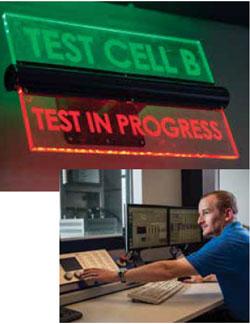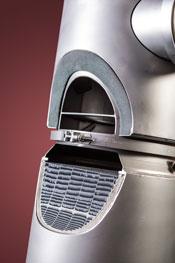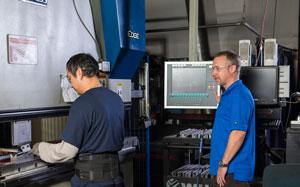- FMA
- The Fabricator
- FABTECH
- Canadian Metalworking
Nett Technologies Clears the Air with Off-road Emissions Control Systems
Helping You Take a Deep Breath
- By Sue Roberts
- January 6, 2014
- Article
- Made In Canada

Members of the NettTech/LaserNett team include (left to right)Laurentiu Stanisor, production supervisor; Alex Stojkovic, marketing manager; Paul Marciniak, LaserNett operations manager; Ivan Luke, project manager, R&D; Leyla Gasimova, accounting; Richard Popik, vice president, operations; John Popik, president; Wayne Moffat, senior technical manager; Peter Mazurek, purchasing (front); Ognen Mangarov, LaserNett customer service representative (back); Jakub Paprocki, LaserNett laser/CAD engineering specialist; Mohamed Khan, controller.
NOx, DPM, AQI, and AQHI are acronyms that aren’t bantered around most engineering departments or manufacturing floors. But when a company is dedicated to reducing toxic engine emissions like nitrogen oxides (NOx) and diesel particulate matter (DPM) to improve the Air Quality Index (AQI) and Air Quality Health Index (AQHI), they can dominate conversations.
Nett Technologies Inc. (Nett-Tech) in Mississauga, Ont., joined the campaign for cleaner air in the early 1990s when it developed high-performance catalytic mufflers that exceeded the regulatory reduction levels of hydrocarbons (HC) and carbon monoxide (CO) for forklifts and off-road equipment used in the construction and mining industries.
Four people worked in a 2,000-sq.-ft. location that housed research and development along with some basic fabrication equipment for sawing, shearing, welding, and rolling. Within two years the portfolio of designs, quick response to customer needs, and faith that success would continue pushed the company into its first expansion.
Several moves and 14 years later, today’s 55,000-sq.-ft. facility is beginning to feel cramped. Much of the floor space is dedicated to a broad range of fabricating and finishing equipment that comprises LaserNett, a spinoff of NettTech spurred by the desire to control part quality and delivery times. When the equipment isn’t producing components for emission control systems, it fulfills contracts for a variety of customers with specialized fabrication needs.
Heavy on Engineers
The employee head count is growing. LaserNett continually searches for operators to cross-train and run the expanding equipment mix, while NettTech actively recruits engineers. Of the current 70 employees, about 60 percent work on the shop floor. A substantial number of the remaining 40 percent are involved in R&D.
“We are very front-end-loaded because there is a lot of engineering involved,” said John Popik, president and co-owner with his brother Richard, vice president of operations, who manages production, quality control, and hiring for the shop. “The engineers here are multidisciplined. For example, they are exposed to computational tool dynamics and manufacturing. Once they have a design, they go on the shop floor to see how the product is made. They know what tests are being done and what the particular product has to withstand. They are also involved in field installations.
“This requirement to follow a design from computer to installation not only makes a good engineer, it makes a better product.”
Everyone is hands-on, regardless of their educational backgrounds, from college degrees to PhDs. “There is a cost to manufacture,” said Popik, “and somebody could design a product without taking manufacturing into consideration then find out that it is impossible to produce. We get ahead of that situation.”
The NettTech products that benefit from this computer-to-installation philosophy include manifolds, mufflers, and catalytic converters to reduce emissions from 5- to 7,000-HP engines. Commercial lawnmowers, locomotives, and generators built to power a small town are some of the emission system recipients. On-road automobiles are not part of the market mix.
“We serve industries that require specialized knowledge—off-road, construction, buses, and we have products that are certified for underground mining. We produce in low quantities, from a single, custom-made product up to maybe 10,000,” Popik said.

Stephen Ashton, lead design/application engineer, monitors results of an emissions test in the new EPA emissions-compliant test cell with fullflow dilution automation for constant value stamping and measurement of raw emissions. Investment in the cell exceeded $3 million. The cell interior is pictured on the front cover.
The emission units are not bolt-on devices. Each system is designed to integrate with a specific engine. That integration can present a number of challenges, particularly when developing a retrofit. For example, a finished system can be fairly large to house the components involved in clearing the air, but it must be designed so it doesn’t create a visibility barrier or interfere with other engine operations.
Cleaner Air Required
Clearing the air is closely tied to government certifications. At any time there may be a half-dozen or more NettTech products going through stringent certification processes required by the U.S. Environmental Protection Agency (EPA) and the California Air Resources Board (CARB). Today’s main market is the U.S., but Popik anticipates significant opportunity as regions of Canada step up regulations.
“The future here is going to be good for our industry and our company,” Popik said. “The U.S. will probably remain the dominant market, but as Canada becomes more involved in protecting our environment, we will be ready with the products.
“Vancouver is one of the cities that has initiated emission requirements, probably because of air quality issues created by the mountains. If a company wants to do construction work for the city, they need to meet emission goals. And Quebec is advanced in emissions awareness. It has initiated some activities to align its standards with those of California and the northeastern U.S. The major cities will lead the way to reducing emissions as people are becoming more aware of emissions-related health effects.”
NettTech shipments, however, are not limited to North America. Customized products satisfy environmental regulation needs for customers in China, Europe, and Australia.
Pushing the Emissions Control Envelope
Standards for verifying emissions control systems, as well as the equipment used to accomplish the verification, have become tighter.
“The testing and final testing in our industry is very expensive. For the verification itself, we can be talking over $1 million,” said Popik. “Standards for the equipment required to test the emissions control units and the equipment to test the testing equipment multiplied by 100 in some cases in 2012. Compare the changes by thinking, if you could use a ruler to measure something before, now you need to use a micrometer.”
Building its own EPA emissions-compliant test cell with full-flow dilution automation for constant value stamping (CVS) and measurement of raw emissions was NettTech’s response to the heightened requirements. The company’s original testing cell, built in 2000, has also been upgraded to meet the new standards.
“Building our own engine dynamometer and the new test cell was one of the most challenging projects we have had, but it’s a critical part of our company,” said Popik. “Our investment in the cell is over $3 million.”
Having testing capabilities in-house shortens delivery to meet customers’ deadlines and not only saves money, but makes money. Emissions testing services, along with consulting for the completion and submission of governmental compliance documentation, are available to outside companies.

A cutaway sample shows the complex inner structure of a diesel particulate filter with a burner. Patented in the U.S. and Canada, the product is engineered to totally remove the black smoke (particulate matter) from exhaust produced by heavy equipment.
“Our strategy has been to offer our customers the extra service—to deal with their paperwork so they don’t have to. So we offer the actual testing and help them get their engines ready and then complete the certification documents. Engine certification can take 40 to 50 engineering labor-hours just for documentation when you are experienced with the process. If you do it only once a year, it can take much longer,” Popik said.
Better Health, Increased Profits
Positive results of emissions control regulations are documented by the government entities that establish the standards, and they are often noticed by customers using the systems.
Popik talked about an effect one customer reported.
“Recently we provided equipment for a forklift fleet cleanup. The customer had a cross-dock operation, loading and unloading containers and shipping throughout the U.S. He had 280 forklifts operating in over 20 acres of buildings. A lot of the redistribution of products for shipping was done inside 52-ft. trailers.
“Regulations prompted his purchase of the emissions control systems, but he called us with another result, saying there was something different about the forklifts following the installations. His company sick days had dropped by 12 percent. We can’t say that improvement was 100 percent due to our equipment and the cleaner air, but it did cause him to order an additional 170 units. The reduction in sick days was money in his pocket.
“Our design cost slightly more than our competitors’ because we actually went to see if it fit and to be sure the oxygen sensor didn’t interfere with the counterweight or other aspects of the forklift operation. But it worked for our customer, and we got our reward with market share.”
As NettTech continues to grow and add to its list of verified emissions control products, its employees take pride in successfully competing with much larger companies.
“Our success with verifications last year put us at the top of the list of companies in this business. Many of them are 10 times our size,” Popik said. “The competition is fierce and delivery times are short. We run a lean operation, and to me that means that we make sure that whatever changes we make to the company are in response to our customers.”
Photos by Jon Evans Photography.
LaserNett’s Diversification Grows Fabrication Contracts
Taking complex emissions control system designs and turning them into fully tested, regulation-compliant units to be integrated with engines is the job of

Quoc “Eric” Kha, CNC press brake operator, checks part tolerances and reviews engineering data with Brant Roettger, IT manager.
LaserNett, Nett Technologies’ (NettTech) sister company.
What started as a few basic fabricating machines as part of NettTech in 1994 has expanded to a full-service shop with laser cutting, metal fabrication, sheet metal bending and rolling, laser engraving, manual and robotic welding, tube bending and perforation, and metal spinning. AWS-certified welders work with aluminum, stainless, and mild steel in manual, semiautomatic, and robotic cells.
In-house powder coating was added in 2013 to offer customers a one-stop fabrication shop.
Running one and a half shifts, the shop has the time and flexibility to produce the emissions control systems and offer metal prototyping, tool and die production, and general metal fabricating services on a contract basis. Metal signage and furniture flow through the shop alongside components for government and military contracts.
“LaserNett’s employees with real manufacturing experience work hand-in-hand with our Nett design engineers to yield value-added service for our laser/fabrication customers. Services can begin at design and follow through production,” said John Popik, president of Nett Technologies and LaserNett. “Our strategy for the shop is diversification.”
subscribe now


Keep up to date with the latest news, events, and technology for all things metal from our pair of monthly magazines written specifically for Canadian manufacturers!
Start Your Free Subscription- Trending Articles
- Industry Events
MME Winnipeg
- April 30, 2024
- Winnipeg, ON Canada
CTMA Economic Uncertainty: Helping You Navigate Windsor Seminar
- April 30, 2024
- Windsor, ON Canada
CTMA Economic Uncertainty: Helping You Navigate Kitchener Seminar
- May 2, 2024
- Kitchener, ON Canada
Automate 2024
- May 6 - 9, 2024
- Chicago, IL
ANCA Open House
- May 7 - 8, 2024
- Wixom, MI














